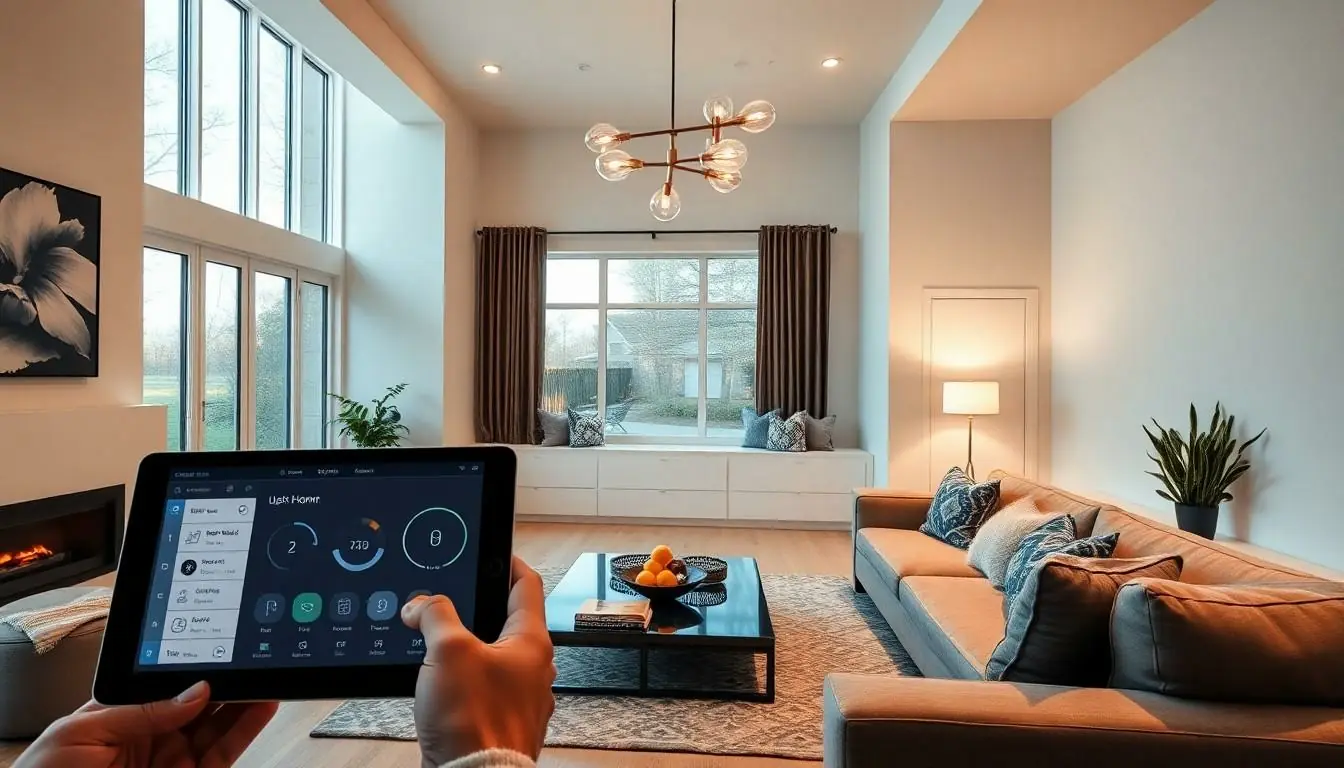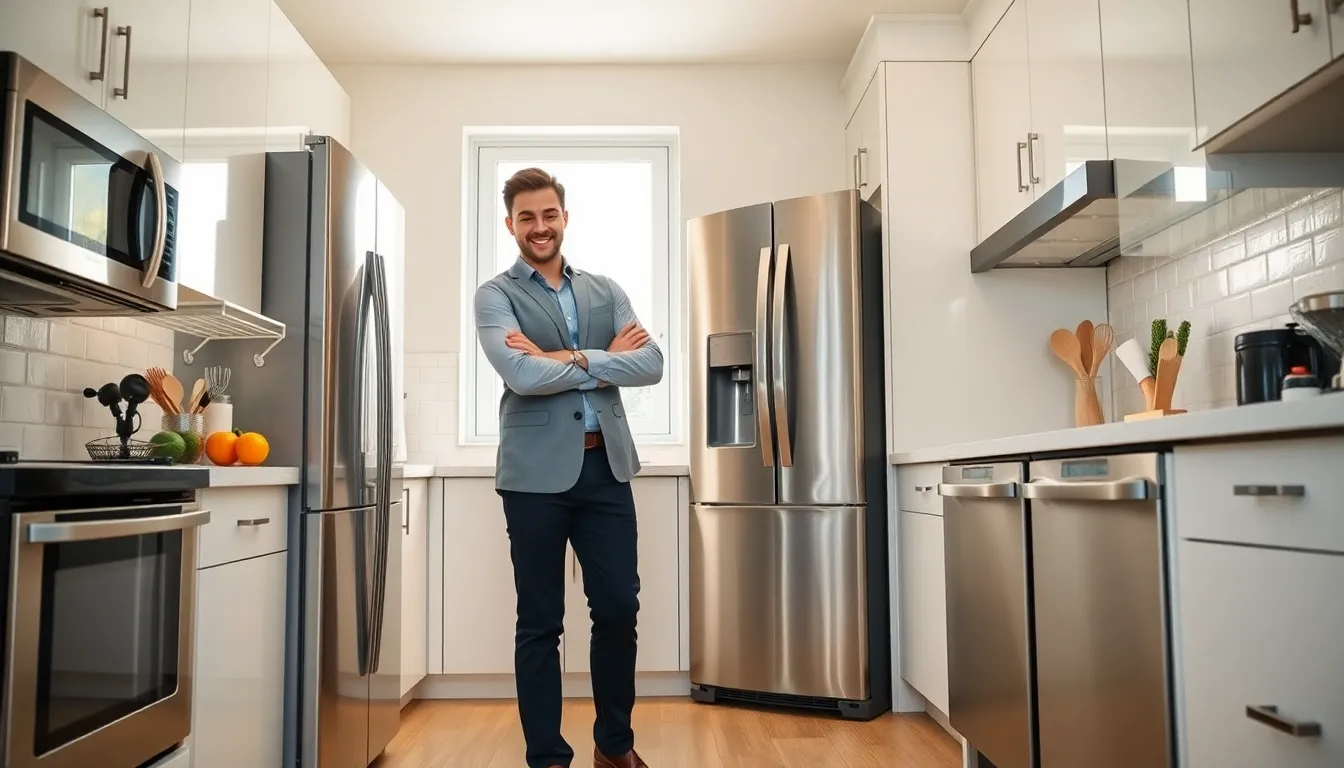Imagine walking into your home and feeling like a wizard with the power to control the very lights around you. Home lighting control isn’t just about flipping switches; it’s about creating an ambiance that makes you feel like royalty—or at least like you’re in a really good movie. With the right system, you can set the mood for a cozy night in or a lively gathering with friends, all at the touch of a button.
Table of Contents
ToggleOverview of Home Lighting Control
Home lighting control refers to systems that manage the intensity, color, and timing of lights in residential spaces. Smart lighting technology offers convenience and energy efficiency. Homeowners can create customized lighting scenes for various activities. For instance, a dimmed setting suits movie nights, while bright, colorful lights can energize a gathering.
One main feature of these systems is remote accessibility. Homeowners can adjust their lights through mobile apps or voice commands, ensuring flexibility regardless of location. Integration with smart home setups enhances this experience, allowing automated lighting schedules based on personal routines.
Potential benefits include not only energy savings but also increased security. Automated lighting can deter potential intruders when users are away. Systems can simulate occupancy by turning lights on or off at specific times.
Various types of home lighting controls exist. Dimmer switches offer a simple upgrade for standard fixtures. Smart bulbs provide color changing features and easy app control. More advanced solutions include whole-home systems that synchronize lighting throughout multiple rooms.
Installation options vary, too. Wireless systems allow for easier retrofitting in existing homes, while wired solutions offer more robust capabilities. Both options cater to different homeowner preferences and configurations, ensuring a suitable choice for enhancing living spaces.
By embracing home lighting control technologies, homeowners improve ambiance, convenience, and energy efficiency. These systems transform ordinary lighting into an integral part of home automation.
Benefits of Home Lighting Control
Home lighting control offers several advantages, making it a valuable addition to any household.
Energy Efficiency
Energy efficiency becomes a major benefit when utilizing home lighting control systems. They allow homeowners to reduce energy consumption by adjusting light intensity and using timers. Many systems enable scheduling, ensuring lights activate only when needed. According to the U.S. Department of Energy, using LED bulbs in conjunction with smart controls can save up to 75% on lighting energy costs. Automatic dimming features also optimize power use, adapting brightness based on natural light levels. Collectively, these features contribute to lower utility bills while promoting sustainable energy practices.
Enhanced Convenience
Enhanced convenience plays a crucial role in home lighting control. Homeowners can manage their lighting from anywhere, whether through mobile apps or voice commands. This flexibility means adjusting lighting for various activities is easy, such as creating a movie night atmosphere with just a few taps. Integration with smart home systems further streamlines the process, allowing for synchronized lighting settings across different rooms. Automated routines can set the optimal brightness during certain times of the day, improving daily life. With these advanced controls, managing home lighting transforms from a task into a seamless part of living.
Types of Home Lighting Control Systems
Home lighting control systems fall into two main categories: smart lighting systems and traditional lighting systems. Each category offers distinct features and benefits to cater to homeowner preferences.
Smart Lighting Systems
Smart lighting systems utilize advanced technology to provide flexibility and convenience. Users can control lights through mobile apps or voice commands. Many smart bulbs offer color-changing capabilities, enabling personalization for various moods and events. Automation plays a crucial role, as these systems can integrate with other smart home devices, adjusting lighting based on schedules or occupancy. For instance, lights may turn on at sunset or dim when watching a movie. These features enhance energy efficiency and security, contributing to overall home automation.
Traditional Lighting Systems
Traditional lighting systems rely on basic controls like dimmer switches and standard light fixtures. Homeowners often find these systems easy to use and familiar. They offer reliable functionality without the need for digital interfaces or smart technology. Users can choose plug-in timers to automate lighting and save energy, as well. While lacking the advanced features of smart systems, traditional options remain cost-effective for those who prioritize simplicity. Many homeowners appreciate the straightforward nature of traditional lighting solutions.
Key Features to Consider
Choosing the right home lighting control system involves evaluating several essential features. These aspects can significantly enhance the functionality and convenience of lighting within a home.
Compatibility with Smart Home Devices
Compatibility plays a crucial role in the effectiveness of home lighting control systems. Many homeowners prefer systems that seamlessly integrate with existing smart home devices. This integration allows for centralized control, enabling users to manage lighting alongside other smart appliances. Popular platforms like Amazon Alexa, Google Assistant, and Apple HomeKit support a wide range of lighting systems, offering robust interoperability. Ensuring compatibility means buyers can create customized automation, making adjustments based on their preferences and schedules. Systems that easily connect with smart assistants increase usability, enhancing the overall experience in managing home environments.
User Interface and Control Options
User interface design greatly impacts how easily individuals interact with their lighting systems. Intuitive controls can streamline the experience by allowing quick adjustments. Mobile applications often provide a user-friendly layout, enabling users to switch scenes, dim lights, or change colors effortlessly. Voice control further simplifies operations, allowing commands for hands-free adjustments. Some systems even offer physical controls like wall panels or remote controls for added convenience. Prioritizing user-friendly interfaces ensures homeowners remain engaged with their lighting options, making it simpler to create desirable atmospheres for any occasion.
Conclusion
Embracing home lighting control opens up a world of possibilities for homeowners. It allows for effortless customization of lighting to suit any occasion while enhancing energy efficiency. With options ranging from smart systems to traditional setups, there’s a solution that fits every lifestyle and budget.
The integration of advanced technology not only simplifies the management of lighting but also contributes to increased security and significant energy savings. Homeowners can enjoy the convenience of adjusting their lighting from anywhere, creating the perfect ambiance with just a few taps or voice commands.
Investing in a suitable lighting control system transforms living spaces into personalized havens, making it easier to enjoy life’s moments in style and comfort.




